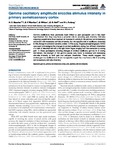Gamma oscillatory amplitude encodes stimulus intensity in primary somatosensory cortex
| dc.contributor.author | Rossiter, HE | |
| dc.contributor.author | Worthen, SF | |
| dc.contributor.author | Witton, C | |
| dc.contributor.author | Hall, SD | |
| dc.contributor.author | Furlong, PL | |
| dc.date.accessioned | 2018-08-13T15:59:32Z | |
| dc.date.available | 2018-08-13T15:59:32Z | |
| dc.date.issued | 2013 | |
| dc.identifier.issn | 1662-5161 | |
| dc.identifier.issn | 1662-5161 | |
| dc.identifier.other | ARTN 362 | |
| dc.identifier.uri | http://hdl.handle.net/10026.1/12133 | |
| dc.description.abstract |
Gamma oscillations have previously been linked to pain perception and it has been hypothesized that they may have a potential role in encoding pain intensity. Stimulus response experiments have reported an increase in activity in the primary somatosensory cortex (SI) with increasing stimulus intensity, but the specific role of oscillatory dynamics in this change in activation remains unclear. In this study, Magnetoencephalography (MEG) was used to investigate the changes in cortical oscillations during four different intensities of a train of electrical stimuli to the right index finger, ranging from low sensation to strong pain. In those participants showing changes in evoked oscillatory gamma in SI during stimulation, the strength of the gamma power was found to increase with increasing stimulus intensity at both pain and sub-pain thresholds. These results suggest that evoked gamma oscillations in SI are not specific to pain but may have a role in encoding somatosensory stimulus intensity. | |
| dc.format.extent | 362- | |
| dc.format.medium | Electronic-eCollection | |
| dc.language | eng | |
| dc.language.iso | eng | |
| dc.publisher | Frontiers Media SA | |
| dc.subject | gamma | |
| dc.subject | primary somatosensory cortex | |
| dc.subject | pain | |
| dc.subject | electrical | |
| dc.subject | stimulus intensity | |
| dc.title | Gamma oscillatory amplitude encodes stimulus intensity in primary somatosensory cortex | |
| dc.type | journal-article | |
| dc.type | Article | |
| plymouth.author-url | https://www.ncbi.nlm.nih.gov/pubmed/23874282 | |
| plymouth.issue | JUN | |
| plymouth.volume | 7 | |
| plymouth.publication-status | Published online | |
| plymouth.journal | Frontiers in Human Neuroscience | |
| dc.identifier.doi | 10.3389/fnhum.2013.00362 | |
| plymouth.organisational-group | /Plymouth | |
| plymouth.organisational-group | /Plymouth/Faculty of Health | |
| plymouth.organisational-group | /Plymouth/Faculty of Health/School of Psychology | |
| plymouth.organisational-group | /Plymouth/REF 2021 Researchers by UoA | |
| plymouth.organisational-group | /Plymouth/REF 2021 Researchers by UoA/UoA04 Psychology, Psychiatry and Neuroscience | |
| plymouth.organisational-group | /Plymouth/REF 2021 Researchers by UoA/UoA04 Psychology, Psychiatry and Neuroscience/UoA04 REF peer reviewers | |
| plymouth.organisational-group | /Plymouth/Research Groups | |
| plymouth.organisational-group | /Plymouth/Research Groups/FoH - Applied Parkinson's Research | |
| plymouth.organisational-group | /Plymouth/Users by role | |
| plymouth.organisational-group | /Plymouth/Users by role/Academics | |
| dc.publisher.place | Switzerland | |
| dcterms.dateAccepted | 2013-06-24 | |
| dc.identifier.eissn | 1662-5161 | |
| dc.rights.embargoperiod | Not known | |
| rioxxterms.versionofrecord | 10.3389/fnhum.2013.00362 | |
| rioxxterms.licenseref.uri | http://www.rioxx.net/licenses/all-rights-reserved | |
| rioxxterms.licenseref.startdate | 2013 | |
| rioxxterms.type | Journal Article/Review |


